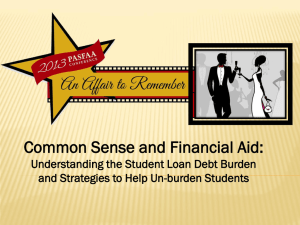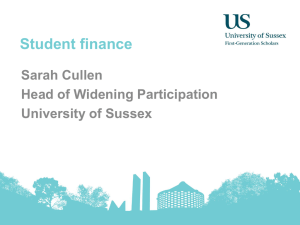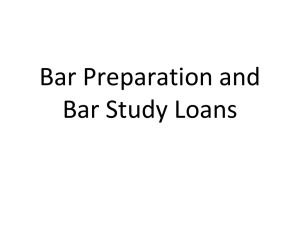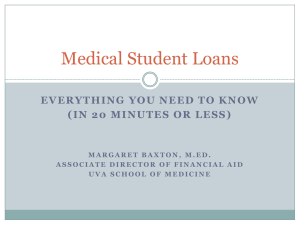Student Loans
advertisement
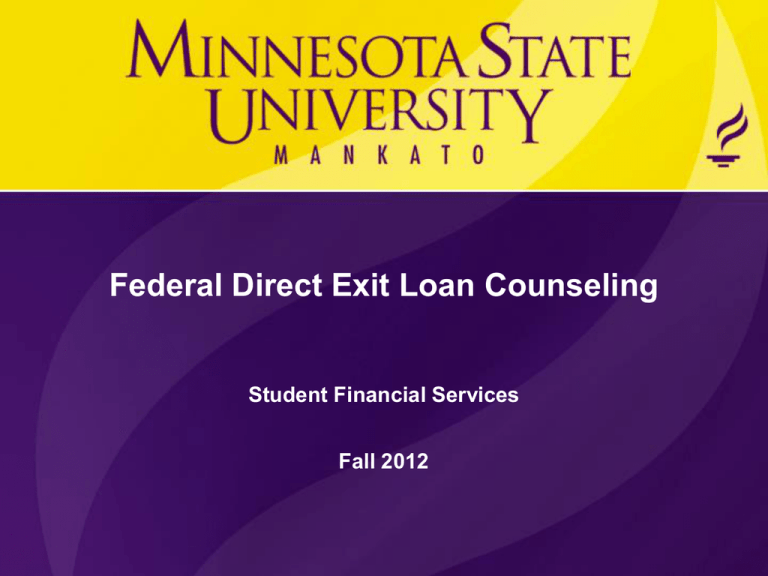
Federal Direct Exit Loan Counseling Student Financial Services Fall 2012 What is Exit Counseling and Why are You Here? Exit counseling is a way for students to understand their rights and responsibilities. Must be completed if you withdraw, graduate, or drop below half-time attendance. Understand the agreement you entered when you borrowed your loans. Objectives for Today Review Federal Direct Student Loans How many loans do I have and where are they? Repayment Plans What if I don’t pay? Consequences of default When and how to get help from your servicers/lenders Be successful and repay your loans. Review Federal Student Loan Programs Federal Student Loan Programs William D. Ford Direct Loan (Direct Loan) Program Loans: < Direct Subsidized Loans < Direct Unsubsidized Loans < Direct Graduate PLUS Loans (for graduate/professional students) Federal Family Education Loan Program (FFEL) Loans: < Subsidized Federal Stafford Loans < Unsubsidized Federal Stafford Loans < Federal Graduate PLUS Loans (for graduate/professional students) Loan Definitions Loan: The money borrowed from a lending institution or the Department that must be paid back. Grace Period: The six-month grace period after you graduate, leave school, or drop below half-time enrollment in which you are not required to make payments towards your loans. Have you used your grace period? Lender: The organization that made the loan initially for you which could be a bank, credit union, or the Department of Education. Loan Definitions, Continued Loan Holder: This is the institution that holds your loan and promissory note and has the right to collect money from you. Loan Servicer: The company that maintains the loan for the lender. This organization will send bills, interest statements, disclosure statements, and any other necessary paperwork. National Student Loan Data System (NSLDS): The Department of Education’s central location that contains information about your federal student loans. Loan Definitions, Continued Deferment: A deferment is a period of time during which your lender will temporarily suspend your regular payments. Forbearance: If you are unable to make your scheduled payments, but do not meet the criteria to qualify for a deferment, the lender/loan holder may allow you to reduce the amount of your payment. Collection Agency: Company that will make all attempts and/or litigation to recover defaulted student loans. Loan Definitions, Continued Master Promissory Note (MPN): MPN is the legal contract between you and the lender (Department of Education) Your promise to repay the loans even if you do not complete your education or are otherwise unhappy with the education you have received. Effective for loans from multiple years Changing Relationships To this point most of your contact regarding your Federal Student Loans has been with MSU (or a previous school). Now most of your questions will be directed to the lender or loan servicer. Subsidized Vs. Unsubsidized Subsidized < Need-Based < No interest is accruing while you are in school Unsubsidized < Non Need-Based < Interest begins accruing the day the loan is disbursed. The interest can be paid while you are going to school or capitalized NOTE: Payment of principle for Subsidized and Unsubsidized begins six months after you have either graduated, dropped below half time, or withdrew. Different Loan = Different Terms *Standard Repayment Plan. Other repayment plans are available. My Loans Check out the National Student Loan Data System for students (NSLDS) < www.nslds.ed.gov Check your loan records Check with your lender Check with the financial aid office Watch letters/emails from Loan Servicer, etc. Check your credit report < www.annualcreditreport.com National Student Loan Data System (NSLDS) www.nslds.ed.gov < Need your Federal PIN number < If you do not have your Federal PIN, it can be obtained at www.pin.ed.gov Repayment Plans Paying on Your Loan You have the option to prepay all or part of your federal student loans before your repayment begins (without penalty). Make payments before they are due or pay a little more each month. Contact loan servicer to make sure extra payment is applied to principal balance. Paying extra each month can reduce total cost of loan over time. Standard Repayment Equal monthly payments Payment term of 10 years Minimum payment of at least $50 per month •1An unsubsidized Stafford loan at 6.8% interest, with a 10-year amortized repayment plan Other Repayment Options Graduated Repayment Plan Extended Repayment Plan Income-Based Repayment Plan Income-Sensitive Repayment Plan Income Contingent Repayment Plan Graduated Repayment Plan Payments start out low and then will increase every two years Payment term of 10 years Loan Amount Beginning Monthly Payment $10,000 $56.67 Ending Monthly Payment1 $159.63 Total Interest Paid $4,726.70 Total Paid2 (Loan + Interest) $14,726.70 $30,000 $478.88 $14,179.62 $44,179.62 $170.00 •1 Payment amounts under graduated plans vary from lender to lender. Your lender will determine the exact payments if you choose this plan. •2 An unsubsidized Stafford loan at 6.8% interest, with a 10-year amortized repayment plan. Extended Repayment Plan Eligible if you received loans after 10/7/1998 and have over $30,000 in federal student loan debt. Repayment term may be as long as 25 years Minimum payment is at least $50 per month Monthly payments may be fixed or graduated •1 An unsubsidized Stafford loan at 6.8% interest, with a 25-year amortized repayment plan. Income- Based Repayment Plan Monthly payment is capped at an amount that is affordable based on your income and family size Must reapply each year Payment term is 10-25 years May qualify for cancellation for any outstanding balance on loans after 25 years Income-Sensitive Repayment Plan Repayment option available only to borrowers who have FFELP loans Monthly payments are based on income and total loan amount Repayment term is 10 years Must reapply each year Income-Contingent Repayment Plan Repayment option available only to borrowers who have Federal Direct Loans Monthly payments are based on income and family size Repayment term is 25 years Must reapply each year for this repayment plan Unpaid portion may be discharged with possible tax liability Loan Consolidation One lender and one monthly payment Flexible repayment options Reduced monthly payments Fixed interest rate Subsidized, Unsubsidized, Graduate PLUS, and Perkins Loans are eligible for consolidation Check with Lender for Private student loans Loan Forgiveness Opportunities Public Service Loan Forgiveness < Borrowers who hold a public service job may be eligible to have a portion of their Direct Loan debt forgiven after making 120 payments. < Visit the following website for more information http://studentaid.ed.gov/repay-loans/forgivenesscancellation/charts/public-service Teacher Loan Forgiveness < Borrowers who teach in an elementary or secondary school that is classified as low income might be eligible to have a portion of their student loan debt forgiven Loan Servicers Federal Loan Servicing (PHEAA) Great Lakes Educational Loan Services Inc. Nelnet Sallie Mae Department of Ed Student Loan Servicing (ACS) Note: For a complete list of loan servicers, refer to the list that was sent to you in the mail by Student Financial Services. What will my payments be? Payments on Federal Direct Loans will be based on your actual Direct Loan debt level The minimum payment on your Federal Direct Loan will depend on payment plan What will my payments be? Repayment charts were included with your Exit mailing. Loan history at MSU and other MnSCU schools is included. Use a loan calculator to estimate what your loan payment will be by going to http://www.finaid.org/calculators. Loan Repayment Examples Money-Saving Tips Sign up to make your monthly payment via automatic debit (ACH) instead of by check Pay on time Tax Benefits for Education A tax credit reduced the amount of income tax you may have to pay. < American Opportunity Credit < Hope Tax Credit < Lifetime learning Tax Credit A deduction reduces the amount of your income that is subject to tax which then reduces the amount of tax you would have to pay. < College Tuition & Fees Deduction < Student Loan Interest Deduction What If I don’t Pay? The Consequences of Default Consequences of Default Ineligible for future financial aid Difficulty in obtaining credit Seizure of tax refunds, wages and/or property Collection agency or other legal action Loss of deferment or monthly payment options Your entire loan balance will be due in full immediately You may not be able to obtain a professional licensure or get hired by an employer who performs credit checks Debt Management Budget (monthly) Total Monthly Income Rent Student Loans $2100 $700 $220 Electric $60 Heat $100 Cable/Phone/Internet $120 Food $500 Entertainment $150 Credit Card Payment $100 Transportation (car payment, gas, insurance) $400 Savings $50 Total: -$300 Your Educational Loan Payments should be considered fixed expense like rent and food! When and How to Get Help! Contact your Lender/Servicer Experience repayment difficulty Need a deferment or forbearance Change employer or employer address Your Lender/Servicer Will Want to Help If you are experiencing repayment difficulties there are things your Lender or Servicer can do to help you out. < < < < Deferment Forbearance Change your repayment plan Loan cancellation Veteran’s Options Recent legislative changes have created new options for Veterans. Contact your lender or servicer to find out more information on these options that may be available to you as a Veteran. Be Successful and Repay Your Loans Resolving a Dispute or Problem Contact your lender or servicer first If unable to resolve with your loan holder, contact the Federal Student Aid (FSA) Ombudsman for assistance. Phone number: (877) 557-2575 Studentaid.gov under “Repay Your Loans” Borrower’s Rights and Responsibilities Borrower Rights Loan obligation information Copy of Promissory Note Original Paid-in-Full Notice Interest rates/fees Loan balance Repayment schedule Notification of Loan Servicer Borrower Rights Interest benefits Grace period Pre-payment without penalty Deferment while in school Request forbearance or deferment Borrower Responsibilities Complete Exit Loan Counseling at www.studentloans.gov Repay loans even if you < Do not complete your education < Are unhappy with the education you have received < Can’t find employment Borrower Responsibilities Maintain contact with your lender/servicer < Notify your lender/servicer any time you change your address < Anytime you change your phone number < Change your name < Cannot make a payment Make monthly loan payments when the grace period has ended Notify your lender/servicer of anything that might change your eligibility for an existing forbearance or deferment. Personal Data Information about your loans are given to the major credit reporting agencies. To avoid telemarketing and mass mailings based on that information consider registering with the National do not call registry at < 1-888-382-1222 (TTY 1-866-290-4236) or < https://www.donotcall.gov Final Words Your student loan debt is an investment in your future that no one can take away from you. “If a man empties his purse into his head, no man can take it away from him. An investment in knowledge always pays the best interest.” Benjamin Franklin Questions?




